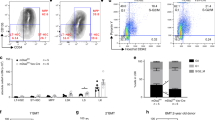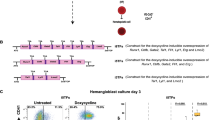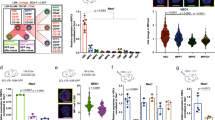Abstract
Vascular endothelial growth factor (VEGF) is a principal regulator of blood vessel formation and haematopoiesis1,2, but the mechanisms by which VEGF differentially regulates these processes have been elusive. Here we describe a regulatory loop by which VEGF controls survival of haematopoietic stem cells (HSCs). We observed a reduction in survival, colony formation and in vivo repopulation rates of HSCs after ablation of the VEGF gene in mice. Intracellularly acting small-molecule inhibitors of VEGF receptor (VEGFR) tyrosine kinase dramatically reduced colony formation of HSCs, thus mimicking deletion of the VEGF gene. However, blocking VEGF by administering a soluble VEGFR-1, which acts extracellularly, induced only minor effects. These findings support the involvement in HSC survival of a VEGF-dependent internal autocrine loop mechanism (that is, the mechanism is resistant to inhibitors that fail to penetrate the intracellular compartment). Not only ligands selective for VEGF and VEGFR-2 but also VEGFR-1 agonists rescued survival and repopulation of VEGF-deficient HSCs, revealing a function for VEGFR-1 signalling during haematopoiesis.
This is a preview of subscription content, access via your institution
Access options
Subscribe to this journal
Receive 51 print issues and online access
$199.00 per year
only $3.90 per issue
Buy this article
- Purchase on SpringerLink
- Instant access to full article PDF
Prices may be subject to local taxes which are calculated during checkout



Similar content being viewed by others
References
Ferrara, N. et al. Heterozygous embryonic lethality induced by targeted inactivation of the VEGF gene. Nature 380, 439–442 (1996)
Carmeliet, P. et al. Abnormal blood vessel development and lethality in embryos lacking a single VEGF allele. Nature 380, 435–439 (1996)
Janowska-Wieczorek, A., Majka, M., Ratajczak, J. & Ratajczak, M. Z. Autocrine/paracrine mechanisms in human hematopoiesis. Stem Cells 19, 99–107 (2001)
Bautz, F., Rafii, S., Kanz, L. & Mohle, R. Expression and secretion of vascular endothelial growth factor-A by cytokine-stimulated hematopoietic progenitor cells. Possible role in the hematopoietic microenvironment. Exp. Hematol. 28, 700–706 (2000)
Shalaby, F. et al. Failure of blood-island formation and vasculogenesis in Flk-1-deficient mice. Nature 376, 62–66 (1995)
Kabrun, N. et al. Flk-1 expression defines a population of early embryonic hematopoietic precursors. Development 124, 2039–2048 (1997)
Radtke, F. et al. Deficient T cell fate specification in mice with an induced inactivation of Notch1. Immunity 10, 547–558 (1999)
Gerber, H. P. et al. VEGF is required for growth and survival in neonatal mice. Development 126, 1149–1159 (1999)
Solar, G. P. et al. Role of c-mpl in early hematopoiesis. Blood 92, 4–10 (1998)
Austin, T. W., Solar, G. P., Ziegler, F. C., Liem, L. & Matthews, W. A role for the Wnt gene family in hematopoiesis: expansion of multilineage progenitor cells. Blood 89, 3624–3635 (1997)
Browder, T. M., Abrams, J. S., Wong, P. M. & Nienhuis, A. W. Mechanism of autocrine stimulation in hematopoietic cells producing interleukin-3 after retrovirus-mediated gene transfer. Mol. Cell. Biol. 9, 204–213 (1989)
Lang, R. A., Metcalf, D., Gough, N. M., Dunn, A. R. & Gonda, T. J. Expression of a hemopoietic growth factor cDNA in a factor-dependent cell line results in autonomous growth and tumorigenicity. Cell 43, 531–542 (1985)
Wedge, S. R. et al. ZD4190: an orally active inhibitor of vascular endothelial growth factor signalling with broad-spectrum antitumor efficacy. Cancer Res. 60, 970–975 (2000)
Sun, L. et al. Design, synthesis, and evaluations of substituted 3-[(3- or 4-carboxyethylpyrrol-2-yl)methylidenyl]indolin-2-ones as inhibitors of VEGF, FGF, and PDGF receptor tyrosine kinases. J. Med. Chem. 42, 5120–5130 (1999)
Gille, H. et al. Analysis of biological effects and signalling properties of Flt-1 and KDR: A reassessment using novel highly receptor-specific VEGF mutants. J. Biol. Chem. 10, 3222–3230 (2000)
Park, J. E., Chen, H. H., Winer, J., Houck, K. A. & Ferrara, N. Placenta growth factor. Potentiation of vascular endothelial growth factor bioactivity, in vitro and in vivo, and high affinity binding to Flt-1 but not to Flk-1/KDR. J. Biol. Chem. 269, 25646–25654 (1994)
Zeng, H., Dvorak, H. F. & Mukhopadhyay, D. Vascular permeability factor (VPF)/vascular endothelial growth factor (VEGF) receptor-1 down-modulates VPF/VEGF receptor-2-mediated endothelial cell proliferation, but not migration, through phosphatidylinositol 3-kinase-dependent pathways. J. Biol. Chem. 276, 26969–26979 (2001)
Barleon, B. et al. Migration of human monocytes in response to vascular endothelial growth factor (VEGF) is mediated via the VEGF receptor flt-1. Blood 87, 3336–3343 (1996)
Lyden, D. et al. Impaired recruitment of bone-marrow-derived endothelial and hematopoietic precursor cells blocks tumour angiogenesis and growth. Nature Med. 7, 1194–1201 (2001)
Gerber, H. P. et al. Vascular endothelial growth factor regulates endothelial cell survival through the phosphatidylinositol 3′-kinase/Akt signal transduction pathway. Requirement for Flk-1/KDR activation. J. Biol. Chem. 273, 30336–30343 (1998)
Behringer, D., Kresin, V., Henschler, R., Mertelsmann, R. & Lindemann, A. Cytokine and chemokine production by CD34 + haemopoietic progenitor cells: detection in single cells. Br. J. Haematol. 97, 9–14 (1997)
Bellamy, W. T. et al. Vascular endothelial cell growth factor is an autocrine promoter of abnormal localized immature myeloid precursors and leukemia progenitor formation in myelodysplastic syndromes. Blood 97, 1427–1434 (2001)
Fiedler, W. et al. Vascular endothelial growth factor, a possible paracrine growth factor in human acute myeloid leukemia. Blood 89, 1870–1875 (1997)
Dias, S. et al. Inhibition of both paracrine and autocrine VEGF/VEGFR-2 signalling pathways is essential to induce long-term remission of xenotransplanted human leukemias. Proc. Natl Acad. Sci. USA 98, 10857–10862 (2001)
Taraseviciene-Stewart, L. et al. Inhibition of the VEGF receptor 2 combined with chronic hypoxia causes cell death-dependent pulmonary endothelial cell proliferation and severe pulmonary hypertension. FASEB J. 15, 427–438 (2001)
Kasahara, Y. et al. Inhibition of VEGF receptors causes lung cell apoptosis and emphysema. J. Clin. Invest. 106, 1311–1319 (2000)
Ryan, A. M. et al. Preclinical safety evaluation of rhuMAbVEGF, an antiangiogenic humanized monoclonal antibody. Toxicol. Pathol. 27, 78–86 (1999)
Gerber, H. P., Kowalski, J., Sherman, D., Eberhard, D. A. & Ferrara, N. Complete inhibition of rhabdomyosarcoma xenograft growth and neovascularization requires blockade of both tumour and host vascular endothelial growth factor. Cancer Res. 60, 6253–6258 (2000)
Hennequin, L. F. et al. Design and structure-activity relationship of a new class of potent VEGF receptor tyrosine kinase inhibitors. J. Med. Chem. 42, 5369–5389 (1999)
Smolich, B. D. et al. The antiangiogenic protein kinase inhibitors SU5416 and SU6668 inhibit the SCF receptor (c-kit) in a human myeloid leukemia cell line and in acute myeloid leukemia blasts. Blood 97, 1413–1421 (2001)
Acknowledgements
We thank E. Humke and F. Radtke for discussions and advice; and L. Lasky, F. de Sauvage and D. Eaton for critical review of the manuscript and comments. We also thank M. Kelly, K. Broderik and the Genentech animal facility for animal care and breeding; L. Thom for tail DNA isolation and genotype analysis; and B. Li and B. Moffat for VEGF mutants. We also thank P. Schow and C. Grimmer for FACS analysis; G. Hatami, L. Leong and L. Cabote for blood cell analysis; and M. Van Hoy, E. Pegg, D. Eberhard and K. Hillan for pathology support.
Author information
Authors and Affiliations
Corresponding author
Ethics declarations
Competing interests
The authors declare that they have competing financial interests owing to employment and company stock ownership.
Rights and permissions
About this article
Cite this article
Gerber, HP., Malik, A., Solar, G. et al. VEGF regulates haematopoietic stem cell survival by an internal autocrine loop mechanism. Nature 417, 954–958 (2002). https://doi.org/10.1038/nature00821
Received:
Accepted:
Issue Date:
DOI: https://doi.org/10.1038/nature00821
This article is cited by
-
Biology and therapeutic targeting of vascular endothelial growth factor A
Nature Reviews Molecular Cell Biology (2023)
-
Autocrine S100B in astrocytes promotes VEGF-dependent inflammation and oxidative stress and causes impaired neuroprotection
Cell Biology and Toxicology (2023)
-
Hematologic toxicities of sunitinib in patients with gastrointestinal stromal tumors: a systematic review and meta-analysis
International Journal of Colorectal Disease (2022)
-
How VEGF-A and its splice variants affect breast cancer development – clinical implications
Cellular Oncology (2022)
-
CPSF4 promotes tumor-initiating phenotype by enhancing VEGF/NRP2/TAZ signaling in lung cancer
Medical Oncology (2022)



